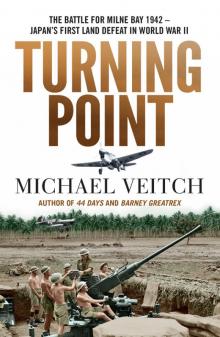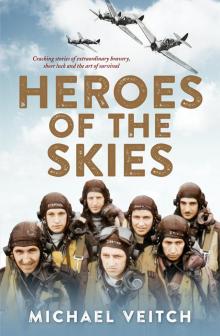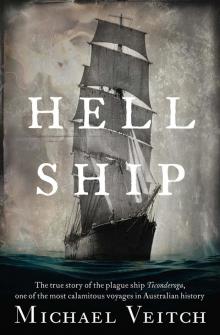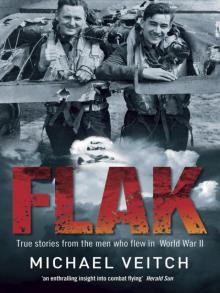- Home
- Michael Veitch
Turning Point Page 5
Turning Point Read online
Page 5
These last couple of days, however, it appeared the ruse was up. In the previous 24 hours, the garrison went onto full alert as a formation of six approaching enemy aircraft was reported by Coastwatchers at their lonely positions along Papua’s northern coast. This was later corrected to one aircraft – and then, bizarrely, increased to ten. In the end, a single Catalina flying boat was observed cruising overhead in a southerly direction.
Just hours later, the sirens sounded again as another aircraft was reported, and this one did make an appearance. A gunner from the 2/3rd Light Anti-Aircraft Regiment observed that:
a twin-engined single-tailed bomber flew over at about 1500 feet. It was not until it changed course that the big red roundel of Japan was clearly seen. According to instructions, no guns were fired. The aircraft left the area in a northeasterly direction without incident.
None of this did anything to assuage the frayed nerves of the men at Milne Bay. When a Japanese aircraft was spotted, all work and activity would cease and, like an animal attempting to conceal itself by blending into the background, the entire garrison would freeze, their eyes and ears straining upwards. Only the movement of the barrels of the anti-aircraft guns as they tracked across the skies, their aim fixed on the enemy, would break the tableau.
The fact that they seemed to have fooled the Japanese thus far amazed the men on the ground at Gili Gili, but all knew that their luck could not last forever.
Onboard the Tasman, an agitated Sub-Lieutenant Champion found Brigadier Field, saluted and hurriedly explained the situation, adding that his arrival, as well as the first of the several thousand men of his 7th Brigade, was extremely welcome. With a Japanese presence in the area, it was deemed necessary that the small armada hurry the unloading of the men and their equipment, while the nervous ships’ captains looked on.
As Champion escorted Field along the rough track leading away from the wharf for his first look at the garrison, the brigadier saw immediately that there was a great deal of work to be done.
CHAPTER 6
FIELD TAKES CHARGE
As Dudley McCarthy’s official history, published by the Australian War Memorial, states, ‘It must have seemed to Field on his arrival at Milne Bay that the possibility of a battle might be the least of his worries.’ His first inspection was of the vital airstrip, which, to his satisfaction, was in an advanced stage, almost ready for the laying down of the Marston matting thanks to the efforts of the American engineers. The docking and unloading system at the wharf at Gili Gili was still rudimentary, however, and painfully slow.
Milne Bay’s vertiginous coral shelf shorelines allowed ships of up to 5000 tons to berth within 40 feet of the bank, and cargo was loaded on a series of floating pontoons, which had been constructed with Papuan labour. It was not possible, however, to load directly into the trucks and vehicles themselves, so hours of labour-intensive reloading were required.
But it was the road system leading away from the wharf that presented Field with his greatest headache. Major Margetts had informed him that, despite his best efforts, there was still not more than 20 miles of roads with anything like a formed surface, and vast sections were just 10 feet wide, making two-way traffic impossible.
An inspection carried out over the next few days revealed at least seventeen small wooden bridges in the main area, all of which would have to be either strengthened or replaced to allow them to accept even moderately heavy military traffic. Although they were infantrymen, Field’s 7th Brigade were ordered to put down their rifles and pick up shovels. Milne Bay’s infrastructure would need to be built by hand. One of their earliest tasks was to construct passing places and loops on the roads, to allow vehicles to move by one another without the risk of putting a wheel onto the muddy verges and becoming bogged.
With some relief, Major Margetts handed over command of the Milne Bay garrison to Brigadier Field, enabling Margetts to return to the vital build-up of his own anti-aircraft unit, which was soon to be greatly tested in battle.
•
As if preparing the Milne Bay area for an expected Japanese attack was not a formidable enough task, on 11 July Field received instructions from Townsville to begin reconnoitring for a second airfield in the more protected but considerably more inaccessible area of Waigani, four miles inland, to the east of the half-completed No. 1 Strip. For this task, more American engineers – two companies of the 43rd Engineering Regiment, in fact – would soon be arriving from Townsville. Until then, the work would have to be done by Field’s men, who, it was becoming increasingly evident, had arrived woefully ill-prepared for the tropics.
Almost all of the 7th Brigade’s men were in summer-weight shorts and shirts rolled to the elbows, leaving their arms and legs exposed to the malarial mosquitoes. The repellent cream with which all had been issued was soon found to be useless, and mosquito nets had not yet been handed out, having been stored in an inaccessible part of the Tasman’s holds. Quinine tablets were available, but, bizarrely, the men were ordered to refrain from taking them for seven days after their arrival. Added to this was the arrival of several hundred local workers, providing a ready pool of the malarial disease itself, which would soon spread through the ranks of the uninfected. As it had with Major Margetts’ men, the first malarial cases from the 7th Brigade began to present within days.
Assessing his own staff, as well as those of the other units at Milne Bay, Field arrived at the conclusion that the only officer with any experience of active service in the present war was himself; four others on his staff had seen fighting in the 1914–18 war. Outside his HQ, established in the old plantation manager’s house at Gili Gili, the three battalions of the 7th Brigade were fully occupied making bridges and roads, or labouring on the wharf and at the airfield – all vital tasks in making the place defensible. As at Townsville, however, this left precious little time for Field to provide his men with the jungle training and familiarisation they needed, so his brigade was, he knew, woefully unprepared.
Before arriving at Milne Bay, they had trained around Brisbane and taken part in some exercises, but even there few had had the chance to use their rifles. As one soldier of the 7th Brigade’s 61st Battalion remembered, ‘I’d only fired seven shots out of my rifle prior to Milne Bay … in those days every round of ammunition had to be accounted for … we just didn’t have much of it.’ A man from the 9th Battalion acknowledged that the training had brought them to a level of physical fitness, but that was about it. Their clothing was unsuitable, and their weapons were surplus from the last war. ‘We had never advanced over covering fire of any kind,’ he recalled.
It was becoming clear to Field that his brigade alone would not be sufficient to defend Milne Bay in the face of a determined Japanese landing. A second AIF unit – preferably a regular one that had battle experience – was also needed. He wrote in his diary:
I had in mind the strategic importance of the south-east area of New Guinea and the earlier futility of defending localities in the south-west Pacific with ‘Penny Packets’. So many had been knocked off before – surely the importance of Milne Bay justified its holding in strength.
General Blamey concurred, and selected the desert veterans of the 18th Infantry Brigade, back from the Middle East since May and currently undergoing jungle training around Kilcoy, in south-east Queensland. At their head was the highly capable, though somewhat rotund, figure of Brigadier George Frederick Wootten, who, despite being of only modest height, tipped the scales at 280 pounds. Yet this in no way indicated a lack of dash or skill on the battlefield. When due for rotation away from the battlefield at Tobruk, Wootten had succeeded in extracting his entire brigade on a moonless night in August 1941 without the Germans having the slightest idea.
As far as Field was concerned, the men of Wootten’s 18th Brigade could not get to Milne Bay fast enough, for the Japanese were showing more and more interest in this little corner of Papua. In the first half of July 1942, reconnaissance flights became more frequent, and al
though the cloak of silence was maintained, it seemed almost inconceivable that the enemy remained yet unaware of their presence. In this, the Australians were aided by the single element that was making their own lives such a misery: the weather.
Although the men at Milne Bay felt vulnerable and exposed, the scale of the garrison and its activities were in fact difficult to determine from the air. When for the brief moments the rain and the mist cleared, the garrison appeared as a mere pinprick in the jungle expanse. And with the Japanese lacking in accurate maps of the area, the build-up of the Allied force eluded them.
Then, on the evening of 21 July, reports came through to Field’s HQ of a landing being made on the northern coast of the Owen Stanley Range, at the mission villages of Buna and Gona. This was roughly 186 miles from Milne Bay, but only half that distance from Port Moresby. The invasion convoy of four destroyers, one cruiser and a large transport had in fact been spotted by aerial reconnaissance earlier that day in the waters off the southern coast of New Britain, but was later lost. Hence, completely unmolested, the Japanese arrived close off the beach at Buna, where their destroyers turned their guns to shore and opened fire. At exactly 5 p.m., several thousand green-clad army troops scrambled down the ship’s rope nets and into assault barges, employing their favourite tactic of striking in the late afternoon, not long before darkness arrived, preventing air attack. The handful of Australian militia troops stationed at Buna were quickly overwhelmed. The Japanese southward drive to the Papuan capital had begun.
The next day Field received an urgent signal from the Coastwatchers along Papua’s northern rim, reporting Japanese warships on the move; this led him to believe an attack on Milne Bay was imminent. Beach defences were manned and evacuation kits prepared. In fact, the Coastwatchers were reporting the movements of the Buna convoy. The attack on Milne Bay – the second part of the Japanese campaign to take Port Moresby – was not yet ready. Field had won a reprieve, but it would not be a long one.
Better news received this day was that the final piece of Marston matting had been slotted into place and the No. 1 Strip was now operational. The RAAF could begin arriving as soon as it wished. Although he had not been there at the start, Field appreciated this feat of engineering, undertaken in one of the most difficult locations imaginable. The fact that it had taken a mere 22 days from start to finish, and was three days ahead of schedule, was a further testament to the skill and dedication of the American engineers.
The runway stretched 5100 feet from east to west, and was 100 feet wide. A rise at the western end was still being flattened out, which would add another 300 feet to the total length. Dispersal areas for two fighter squadrons and a bomber squadron had been made just off the main runway.
As remarkable as this airfield in the jungle was, however, it would not be an easy place for pilots to work out of. As Pilot Officer Bruce ‘Buster’ Brown of 75 Squadron said later, it was quite simply ‘the worst airstrip I have ever operated off … or am ever likely to’.
CHAPTER 7
AN UNEXPECTED ARRIVAL
Squadron Leader Peter Turnbull, DFC, was not having a good day. Leading his 76 Squadron pilots on their first ever combat mission was supposed to have been a relatively straightforward affair, intended to give the boys their first look at the jungle. The plan was to make a quick strike on some enemy anti-aircraft positions and then bolt home before the Japanese even knew they were there. But it had almost ended in disaster.
The mission was simple enough: take off with five new pilots from Port Moresby’s Twelve Mile Strip, drop a couple of bombs on the enemy positions around Gona, which they had overrun during the last few days, then turn around and race home again, flying over the Owen Stanleys. It was just the sort of live training which Turnbull’s pilots – fresh from instruction in Townsville, with no experience of New Guinea whatsoever – needed. The Japanese, Turnbull knew, rarely flew standing patrols, and as long as his Kittyhawks didn’t hang around long enough for the Zeros to get airborne, his men should be able to get back unscathed and add their first mission to their logbooks.
Turnbull could see above him the reassuring pale-blue undersides of eight P-39 Airacobras from the US 41st and 80th Fighter Squadrons, providing top cover just in case they ran into any trouble. As he made his way towards the target, it may not have occurred to Turnbull that he was making history, leading the first Australian fighter-bomber sortie against the Japanese in the Pacific War.
Around 100 miles from the target, he had more urgent concerns as the weather began to close in and banks of cloud loomed on all sides. Looking around him to keep his young pilots together, he then searched frantically for his American escort, only to find the skies above him empty, the two formations having become separated. Cursing, Turnbull signalled his men to close in and keep an eye on each other. They would proceed to the target alone.
A few minutes later the coast appeared ahead, and Turnbull muttered thanks to the weather gods for clearing their run to the target. Gaining some height, he spotted the Japanese gun emplacements adjacent to the mission buildings a few thousand feet below. His five pilots were strung out in line, just as he had instructed them. Engaging the mechanism to arm his bomb after its release, he prepared to be the first to put his Kittyhawk into a steep dive to the target.
Suddenly the sky above Turnbull was filled with planes. For a moment he believed his American friends had returned, but his blood ran cold as he saw large red circles under their wings.
Two flights of Zeros – eight aircraft – having taken off from their large base at Rabaul, had arrived directly over Gona just as he and his very inexperienced pilots were preparing to dive-bomb it. The timing of the Japanese could not have been more perfect. Breaking radio silence for the first time, Turnbull yelled at his men to jettison their bombs immediately and get the hell out of there. His several weeks’ flying in defence of Port Moresby the previous April had taught him that the Kittyhawk pilot who tried to dogfight the fast and nimble Zero was very soon dead.
Pulling the release, his bombs fell harmlessly into the sea, and his aircraft, now suddenly 250 pounds lighter, gave a leap upwards in apparent relief. Some of Turnbull’s men had dived at full throttle and scattered into nearby cloud, but now the sky in front of him was full of Japanese fighters, and a line of tracer fire passed close over his head.
These were not the standard high-altitude Zeros, but the relatively new Type 32 variant, known by the Allies as ‘Hamp’, with clipped wings and more powerful motors, making them superb at low levels. One crossed Turnbull’s sights and he immediately pressed the firing button, but thought better of pressing home the attack. Throwing his stick and rudder simultaneously into one corner, his Kittyhawk plunged downwards and rolled, in a manoeuvre known colloquially as a ‘bink’, which the lighter Japanese aircraft could not follow.
Emerging from the melee, Turnbull turned south towards Moresby, looking around to see who, if anyone, was accompanying him. On his left and right, amazingly, were Flying Officer Max Bott and Sergeant Brian Carroll; both had followed their boss and also fired off a few shots, hoping to hit something before diving away with utmost haste. Now the three of them were speeding along the northern coast of Papua, knowing their best speeds could be maintained at low altitude.
And speed was now of the essence, as they were being doggedly pursued by an indeterminate number of those Zeros which had jumped them over the target. For almost 100 miles the chase ensued, throttles fully open, the Australian pilots putting their faith in their emergency boost, which gave them maximum speed but guzzled fuel at an alarming rate.
Gradually the Japanese aircraft seemed to fall further behind, waning to specks in Turnbull’s mirror, before finally breaking off the pursuit. His Kittyhawk’s liquid-cooled Allison engine was being belted, its temperature nudging the red. Even worse, the needle on his fuel gauge was dropping rapidly. None of them would make it back to Moresby.
There was only one airstrip in the vicinity, and Turnbull
had never landed on it – and nor had anyone else. In fact, he was not exactly sure if it was even finished – but his squadron was slated to be moving there in a few days’ time, so he decided to find out. Quickly consulting the map strapped to his knee, Turnbull clicked the dial of his compass around and set course for Milne Bay. What the garrison commander, not to mention the notoriously lively anti-aircraft gunners by the side of the strip, would make of his unexpected arrival was anyone’s guess.
Just after half past four on the afternoon of 22 July, the defenders of the Milne Bay garrison turned their heads skywards towards the alarming sound of approaching aircraft. These were not the relatively distant sounds of the odd enemy reconnaissance plane, but low-level, loud and deliberate. All believed that this, surely, was it – the Japanese had given up their feigned ignorance of the garrison and were finally coming to strike.
Gun positions were manned, and slit trenches filled. Then the surprised call went up: ‘They’re ours!’ Moments later, the first aircraft tyres touched down on the Marston matting of Milne Bay’s No. 1 Strip. The air force had arrived.
•
In two years of combat flying, the 25-year-old Peter St George Bruce Turnbull had already seen a great deal of war. From Armidale in northern New South Wales, the young country lad had shown a fondness for horses, dancing and girls – who, for their part, seemed happy to spend time in his company too, admiring his striking dark features. Turnbull had joined the Light Horse militia a couple of years before the war, but transferred to the RAAF in January 1939.
Graduating as a single-engine pilot, he was sent to Egypt to take part in the desert campaign against the Italians, and then later the Germans, where he made a name for himself as a skilled and aggressive fighter pilot. With 3 Squadron, flying the Kittyhawk’s slightly earlier variant, the Tomahawk, and then later the Hurricane, Turnbull carved a swathe through the Italian, German and Vichy French air forces, clocking up over 100 sorties and 200 operational hours’ flying time; he also acquired the status of ‘ace’, with at least nine credited kills, though the RAAF never officially acknowledged the title with any of its pilots. On a single sortie one afternoon in April 1941, he disposed of four German Messerschmitt 110 twin-engine fighters, for which he was awarded the Distinguished Flying Cross.

 Turning Point
Turning Point Heroes of the Skies
Heroes of the Skies The Forgotten Islands
The Forgotten Islands Hell Ship
Hell Ship Flak
Flak Fly
Fly